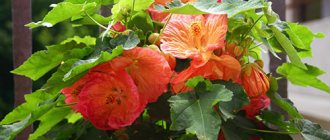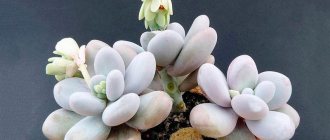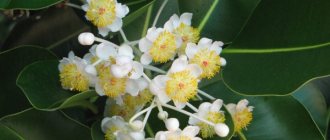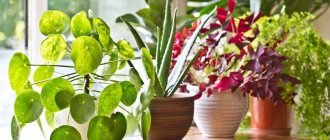Fittonia is a herbaceous perennial from the Acanthaceae family, native to South America, there are four species. Three of them have creeping, spreading stems, the fourth is erect. The name comes from the surname of the English sisters Fitton, who published the first biology textbook.
The flower grows in swampy areas, shady forests of Bolivia, Peru, Ecuador, where the climate is warm and humid. Flower shops offer hybrids obtained through selection, adapted to indoor conditions, the price varies from 100 to 500 rubles.
Description
Fittonia is a round-leaved flower with creeping, thin shoots, up to 10 cm long. The leaves are green, olive with scarlet, red, yellow, pink, silver-blue veins, reminiscent of a cobweb, connected by a small petiole to the stem. Their unusual color scheme is the main decoration of Fittonia.
The flowering plant produces spikelets once, in the summer. Small yellow flowers do not attract attention; it is recommended to pick them off. The plant is capricious and can grow in florariums and glass vessels. Photos of the flower look very impressive; it is kept as an ampelous, ground cover crop.
Features of care
Proper care of herbaceous perennials will allow you to grow a healthy plant that will delight you with its chic appearance.
Illumination
Guzmania - home care, transplantation and reproduction
Often, gardeners lacking experience wonder how to care for Fittonia. To grow perennials at home, you need to ensure there is sufficient lighting in the room where the pots are located. However, direct sunlight should not be allowed to hit the green mass. Experienced gardeners recommend growing Fittonia on windowsills on the east or west side. It is necessary to hang blinds on the windows to provide diffused light to the flowers.
Note! Lack of lighting leads to loss of decorativeness of the leaf plates of the crop. During the winter months, it is advisable to provide additional lighting with fluorescent lamps.
Temperature
In the warm season, the temperature in the room in which flower pots are kept should be between 23-25 °C. In the winter months, the temperature may be slightly reduced, but not fall below 19 °C. Cool air provokes the development of various diseases, which can lead to the death of bushes. To avoid leaf fall, it is recommended to avoid drafts in the room and sudden changes in air temperature. Even in summer, you should not take pots with perennials outside the apartment.
Watering
A representative of the Acanthus family needs systematic soil moistening. When the soil dries out, the plant begins to intensively shed leaves. However, you should not overwater the flowers, as waterlogged soil will cause the root system to rot. Moistening is carried out only during periods of drying of the top layer of soil. For irrigation, you should use settled water at room temperature.
Spraying
In addition to watering, Fittonia needs systematic spraying. If you ignore this recommendation, the humidity level will decrease, which will cause pests to appear on the plant.
It is advisable to spray every day before sunrise and after sunset. Experienced flower growers recommend placing vessels filled with water near pots with plants, which will increase the level of air humidity.
Amazing flowers
Fertilizer
It is necessary to fertilize throughout the year. The amount of fertilizer should not exceed the dosage recommended by the manufacturer. Exceeding the amount of micronutrients in the soil can cause irreparable harm to the bushes. The ideal option for feeding Fittonia would be complex mineral fertilizers.
In winter, fertilizing is applied once every 5-6 weeks. In the summer months, the frequency of fertilizing reaches 1 time in 14 days.
Important! It is worth systematically clearing the soil from weeds by hand.
Trimming
In order to improve the branching of plants, it is recommended to regularly pinch the upper parts of the stems. As it grows, the lower part of the decorative crop begins to become bare.
Fittonia is a flower that is gradually losing its decorative qualities. To rejuvenate the bushes, it is necessary to start pruning them at the end of the last week of March. The measures must be carried out in two stages so as not to harm the green space and not slow down the rate of development of young shoots.
Features of winter care
Caring for Fittonia cannot be called easy. The flower has a difficult time surviving the winter, because at this time of year the heating is turned on in the rooms, which greatly dries out the air. But coolness can also negatively affect the health of the plant and even lead to its death. The room temperature should not fall below 17°C according to the care rules, and the pots should be placed away from the radiators. Near containers with flowers you can place vessels filled with water.
Important! Proper care of the plant will not allow Fittonia to stop blooming or begin to dry out.
Types of Fittonia for indoor growing
Fittonia Verschaffelta or white-veined - about 25 cm high with branching stems, creeping shoots, and large leaves.
There are varieties:
- Silver-veined - with a bright silver mesh, smooth, oval leaf surface, up to 20 cm high, 10 cm long.
- Red - with streaks of pink, red, purple colors.
- Josan - wavy, green leaves with a coral mesh and dark edging along the edges.
- Perseus – light olive background and pastel web.
- White Anna is white-veined, a darker shade with a beautifully bordered stripe.
- The skeleton is small matte velvety olive leaves, a thick burgundy mesh.
- King Cross mosaic is another variety, similar to sea foam or lace, green edging, framed almost the entire white corrugated sheet.
- Pink Wayne is a rich emerald shade with white and pink veins.
- Fortissimo - small oval leaves with bright fuchsia-colored nets.
- Fittonia Mix - several varieties growing together, a decorative composition with many bright veins and different shades of leaves.
- Minima, dwarf - a species created for a bottle garden, florarium, it has miniature shoots with tiny leaves up to 2 cm. There are also varieties Tiger and Red Angel.
- Giant, large - difference in straight shoots, height - 60 cm. Leaves up to 16 cm long, up to 10 cm wide, short petioles. The shiny leaf blade is dark green with pink hues. Rarely grown at home.
- Hypoestes is a Fittonia-like flower from the Acanthus family. When comparing, it is easy to notice the differences: its leaves are larger, soft to the touch, bright spots over its entire surface, the stem is erect.
Main types
Large Fittonia gigantea
This flower is native to Peru, where it grows in tropical forests. The height of the bush can reach a little more than 50 centimeters. There is pubescence on the surface of the purple-red stems. The length of the elliptical leaf plates, depending on age, is 10–16 centimeters, and the width is 4–10 centimeters. Green shiny leaf blades have red veins.
Fittonia verschaffeltii
This not very tall plant can be found in nature only in the tropical forests of Peru and Colombia. The pubescent stems practically creep along the surface of the soil, and therefore they propagate quite easily by layering. Dark green elliptical or ovoid leaf blades have red veins. Their length is 5–10 centimeters and their width is 4–6 centimeters.
FITTONIA on the windowsill. All about CARE and REPRODUCTION. Example of use in COMPOSITION.
Caring for Fittonia at home
Fittonia requires special care.
It is important to regularly drain the water from the pan and ensure that it is not over-dried or waterlogged.
Features of care depend on the time of year:
| Parameter | Spring Summer | Autumn winter |
| Location, lighting. | Bright, extended, with sun protection, east or west facing, away from air conditioning. | Additional artificial light for 2-3 hours a day. Do not place it too close to radiators; it is better to choose south-facing windows. |
| Temperature | +24…+27 °C, do not expose outside. | Not lower than +18 °C, do not allow sharp drops or changes. |
| Humidity | 80-90%, spray 2 times a day with warm filtered water, place a container with wet expanded clay, pebbles, or special moisturizing devices nearby. | |
| Watering | 3-4 times a week, immediately after the soil dries. | Water 2 times a week, every other day after the soil dries. |
| Feeding | From April to September - use mineral fertilizers once every 14 days, and liquid fertilizers per leaf. | Feeding is needed once a month with minerals. |
Features of planting and transplanting
Due to its rapid growth, the plant requires replanting in the spring. The flower must first get used to the new environment for 2-3 days, then it needs to be transplanted.
For planting, it is better to use a shallow, wide container with holes and neutral, light soil. Experts advise buying ready-made mixtures for violets or geraniums.
You can make the substrate yourself. Composition: two parts coniferous or turf soil, one part peat, sphagnum and coarse sand.
Step by step steps:
- Lay a drainage layer of 2/3: fine expanded clay, brick chips, crushed stone, pieces of foam plastic.
- Sprinkle a special mixture for decorative foliage crops on top.
- Remove the plant and shake it off without disturbing the roots.
- Transfer to a disinfected container. To do this, use a solution of manganese, vinegar essence, or chlorhexidine.
- Add the remaining substrate.
- Water, place in a bright, warm place, after draining the water from the pan.
Old, longer shoots in the spring need to be cut or pinched by 2/3 so that young ones grow. The plant must be mature, more than three years old.
Reproduction and transplantation after purchase
Having become the owner of a small, ornamental plant, remember that you will have more worries: propagating Fittonia, replanting, and care will require time and effort. Care work will begin immediately after the Fittonia is at home. She needs to choose a suitable place and conditions, but first the flower needs to be transplanted:
- After removing the culture from a store-bought pot, lightly shake off the roots, but do not expose them. A plant with an open root system is more difficult to take root.
- Prepare a wide and low bowl (for example, a bonsai bowl), since the roots will be located close to the surface. This is the most convenient container for culture. For hanging planting, use a flowerpot.
- You can’t do without drainage (expanded clay). Fittonia loves high humidity, but not stagnant water.
- To keep the soil always moist, place a tray of water under the plant.
- Constant spraying is important; without moisture, Fittonia withers.
- You should not place the plant in bright light: the decorative effect of the foliage is lost. Light partial shade will be the most suitable place.
The soil in the pot must be not just damp, but also warm, otherwise the decorative beauty will die.
Reproduction
Cuttings - with three or five leaves, cut the cuttings with a sharp tool, leave the cuttings in a glass of water or aqua soil until roots form. Then plant in a mini-greenhouse, with a temperature of +25...+28 °C, cover with transparent film, glass, do not forget to open during the day, after rooting, transplant into a separate pot.
Most indoor flowers are propagated in this way - petunia, ficus, geranium, crossandra.
Division - divide the bush into parts, plant each in a separate pot, being careful not to damage the fragile roots.
To propagate by cutting, after tearing off the leaves, sprinkle the long stems with moist soil. A few weeks later, when the roots appear, they should be separated and planted in prepared pots.
Propagation by seeds is not so popular; this can only be done if there is very high-quality seed. In spring, it should be sown in pre-treated, moist soil, covered with film and placed in a lighted place with a temperature of +25 °C. After the sprouts appear, remove the film and pick after 3-5 leaves appear.
General information about fittonia
| Family | acanthaceae |
| Origin | South America |
| Lifespan | perennial |
| Bloom | yes, except for hybrids |
| Shade tolerance | light-loving plant |
| Virulence | No |
| Price | 100-250 rub. |
Initially, Fittonia was grown exclusively in winter gardens or greenhouses, as it died under room conditions. But the work of breeders made it possible to adapt the finicky plant for home maintenance.
The size of the flower and environmental requirements allow it to be used in florariums. For this:
- select a glass container with a lid;
- add drainage and substrate;
- Water thoroughly;
- plant Fittonia;
- complement the composition with pebbles or decorative figures;
- close the florarium;
- after condensation appears, remove the lid for 1.5-2 hours.
After 10 days, the microclimate inside will normalize.
When growing Fittonia in a florarium, make sure that it does not rest against the walls and replant it every six months.
But the closest place to natural conditions for growing Fittonia is the paludarium. This is a special aquarium that imitates a swamp. Here the plant can be kept in a terrestrial, semi-submerged or underwater state. The main thing in this method is to choose the right container and equipment that can maintain the required level of light and humidity. The composition should be supplemented with fountains, decorative figures, as well as plants with similar environmental requirements - aglaonemas or alocasia.
Methods for keeping fittonia
There are several ways to grow Fittonia: flower pot, florarium, aquarium.
Pot
The container suitable for growth is low, up to 7 cm; place drainage and soil at the bottom. It is necessary to create lighting, watering, and humidity. The disadvantage of this method is that you will have to constantly monitor the level of humidity and temperature.
Florarium
For this method, it is preferable to use aqua soil or hydrogel. Instead of a pot - a bottle, an aquarium, a glass. Coconut fiber and expanded clay are for soil; the plant should not come into contact with the walls.
Pros:
- No need to monitor humidity.
- It is enough to water once a month.
- You can place other flowers there for contrast. But replanting and pruning should be done more often.
Aquarium
It requires special containers and equipment to maintain optimal conditions. Cons: slow growth, risk of root rot.
Possible difficulties
- The roots of Fittonia are very thin and fragile, so when replanting you need to handle the plant carefully so as not to damage them.
- The shoots of the plant, due to their fragility, also require careful handling.
- You should not water the flower abundantly immediately after replanting - this can lead to rotting of the roots.
After transplantation, Fittonia must be watered and placed in a slightly shaded place until it resumes growth. The temperature there should be 22 - 26 degrees.
Thus, there is nothing complicated about transplanting Fittonia.
Diseases and pests
If poorly cared for, the flower is susceptible to pests and diseases.
| Damage | Cause | Elimination methods |
| The plant stops growing, withers, the roots soften, and the flower dies. | Root rot. | Treat with drugs: Discor, Trichodermin, Baikal-M, according to the instructions, transplant. |
| There are green insects on the plant, the leaves are sticky, wither, and become deformed. | Aphid. | Spray with a solution of liquid soap, avoiding getting it on the ground. A liter of hot water will require 50 grams. laundry soap. Grind it, dissolve it in water, cool. |
| White coating on the surface. | Mealybug. | First, treat with an alcohol-soap solution. Dissolve 20 grams in a liter of boiling water. soap, cool, add 10 ml of alcohol. In advanced cases, use drugs: Aktara, Phosfamide, Kalipsa. |
| There are brown scales on the shoots, the leaves dry out and fall off. | Shield. | Place separately from other colors, use Actellik. |
| Small insects that drink the juice, areas of the leaf dry out, and holes appear in their place. | Thrips. | Immediately transplant the plant into new soil, wash the pot with laundry soap, and soak in a manganese solution. Treat the plant with Actellik, Karbofos, Fitoverma. |
| Holes appear in the leaves, light dots and cobwebs are visible on top. The leaves curl and dry. | Spider mite. | Isolate the flower, disinfect the tray, window sill, pot. The drugs will help - Omite. Aktofit, Aktellik. |
Possible problems
There are not many problems that Fittonia may have:
- The plant suddenly withered . This usually happens if the bush has been watered abundantly all year round. When caring for a flower, you must carefully follow the watering regime. In some cases, sudden temperature changes can also destroy a plant.
- The lower leaf blades fall off . Most often this process is natural, so there is no need to worry. Just carry out a rejuvenating haircut and remove bare shoots.
- The foliage has turned yellow . This can happen due to waterlogging of the soil. Reduce the volume of liquid added and add it only when the top layer of the substrate is completely dry.
- The tips of the leaf blades have turned brown . This may be due to an excess of nutrient compounds in the soil or to their deficiency.
- The leaves are wrinkled . This reaction is caused by excessive dry air, an abundance of bright light, or exposure of the plant to direct sunlight.
Pests
Fittonia is rarely attacked by pests . More often than others, she can be attacked by:
- scale insects;
- spider mites;
- mealybugs;
- thrips.
Mistakes in caring for Fittonia
Fittonia owners often make mistakes.
| Damage | Cause | Recommendations |
| The plant withers, dries, the leaves fall off. |
|
|
| Leaves are curled and have spots on them. | Lack of moisture. | Increase watering. |
| The lower part of the stem becomes bare. | The flower is aging. | Prune in spring. |
| Leaves dry out and turn brown or yellow. | The air is too dry. Little fertilizer. | Spray, put on a humidifier. Feed with mineral fertilizer for indoor flowers. |
| The plant stretches, the color turns pale. | Lack of light. | Keep in a brighter place, or use an artificial lamp. |
| The edges of the flower dry out. | Excessive or insufficient feeding. | Adjust the frequency of fertilization. |
List of emerging problems and their elimination
| Problems | Causes | Remedies |
| Limp, deformed leaves | Dry air | Requires intense hydration |
| Direct sunlight or too bright lighting | Move to another location | |
| The soil is moist, the leaves are limp | Overwatering. Root rotting | Trim shoots and replant by cuttings |
| Dried edges of leaves | Lack of fertilizer | Fertilize |
| Excess fertilizer | Sprinkle the earth with clean water | |
| Dry air | Increase frequency of spraying | |
| Long thin shoots, small dull leaves | Lack of light | Add additional lighting |
Fittonia Joson is a wonderful plant. The main rule of caring for it is moderation in everything: do not overdry, do not overexpose, do not over-water, do not over-cool. And then the capricious tropical beauty will delight you every day.
Fittonia - sleeping pills at home
In the Chinese teachings of Feng Shui, Fittonia is a symbol of the element of metal, helps to achieve your goal and get rid of indecision and depression, removes negativity, and improves your mood.
The plant brings benefits: it cleanses the air of microbes, saturates it with moisture, and can be kept in the bedroom for a relaxing holiday. The flower calms, helps relaxation, and helps you fall asleep quickly.
According to signs, Fittonia attracts money. People are convinced of this because of the appearance of the leaves, which resemble coins. The plant does not contain poisonous juice and is safe for the home.
How to properly trim and shape a bush?
The problems with growing Fittonia are not reproduction, but proper care. The plant is quite demanding in terms of care, and not everyone manages to grow it. To make the bush lush, pinch the shoots. At this point, two new shoots begin to form, and the bush becomes dense.
Over time, the lower part of the plant becomes bare and loses its decorative effect (in other words: it grows). A simple technique will help to rejuvenate an old plant - pruning old shoots. Just don’t expose the culture completely, as it may die. It is advisable to carry out pruning in several stages so that the plant does not experience stress. But it is best to propagate Fittonia by obtaining a young plant.
Plant several young shoots in one pot at once. This way they will grow faster and create the illusion of a lush carpet of green or reddish shades of leaves.
Fittonia is unique in that it is good in both single and group plantings. You can use it to create interesting floral and decorative compositions, grow it in an aquarium as a miniature plant, or create a bonsai. Therefore, buy a plant, propagate it and get creative, creating unique corners in your home.
How to propagate
Chlorophytum - home care and reproduction
The plant can be propagated during the replanting period, which allows the bushes to be rejuvenated.
Suitable cuttings with 3-5 leaves are cut from the top of the bush. To speed up the rooting process, it is worth choosing shoots whose length reaches 60-70 mm. The cuttings are planted in the sand with the cut tip down. The shoots are covered from above with glass jars. After four weeks, roots should appear on the cuttings. It is important to moisten the sand in a timely manner and remove the cans for ventilation.
For rooting purposes, you can use a container of water, which should only slightly cover the surface of the bottom of the container. The cuttings located in the container are covered on top with a film material, which must be removed every three days for ventilation. The cuttings are systematically moistened by spraying. To speed up the rooting process, you should maintain the temperature in the room where the water containers are located within 28-29 °C. As soon as roots form on the shoots, you can plant the cuttings in a container filled with fertile soil. Reproduction of Fittonia is not a complicated process.
Fittonia in the aquarium
Proper watering, required humidity
When growing Fittonia, you must always remember that this plant is of marsh origin, so it needs moist air. In caring for this flower, creating high humidity is the greatest difficulty for gardeners. Fittonia is characterized by an increased rate of transpiration, that is, it quickly evaporates moisture through the leaves, therefore, watering should be constant and abundant. In addition to watering, the flower needs daily spraying with settled water; Fittonia should be placed on a tray with moistened pebbles, for example, pebbles, expanded clay. However, the pot should not be placed in water. In addition, in order for the care to be complete, it is necessary to increase the air humidity as much as possible; you can place a container of water next to the flower. You need to make sure that the soil is moistened all the time; before watering, the substrate should dry out a little on top. When the leaves become limp and painful, it means that the care is incorrect and the flower does not have enough moisture. Just water the Fittonia a couple of times, and it will immediately come to life and take on a healthy, radiant appearance. However, even if the roots and soil dry out once, the leaves will begin to fall off. But if the soil turns sour due to waterlogging, the roots will begin to rot. For irrigation it is necessary to use settled, warm water.











